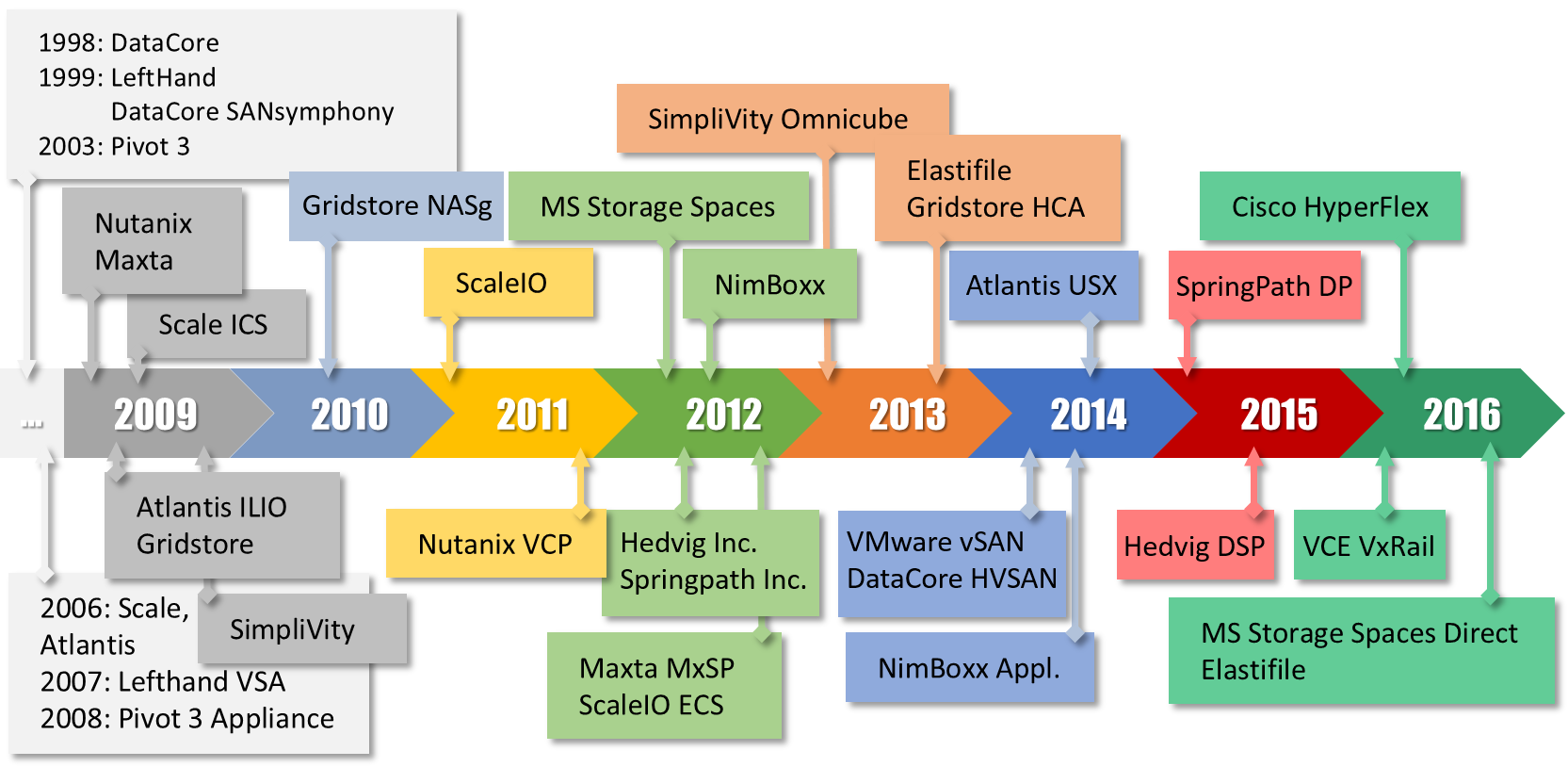Kings and knights beware! All hail the queen of software-defined storage, as DataCore SANsymphony positions itself as a new top-ranking software-defined storage platform in the WhatMatrix comparisons
Quick history lesson Since 2010 many promising startup companies have emerged showing us new software-defined and hyper-converged ways to implement storage into our ever-growing enterprise IT environments. However, looking back at history, it has to be said that this seemingly new and fresh approach to storage is actually not that new at all. Software-defined storage initiatives already took flight in the late nineties and were led by a few distinct companies. One of them being DataCore, a company that was originally founded in the US back in February 1998.
The fact that DataCore is still very much alive today and has over 10,000 customers worldwide, makes you wonder how the current version of its storage solutions compares to the relative newbies. We decided to put this to the test by executing our rigorous evaluation process for both DataCore SANsymphony and DataCore Hyper-converged Virtual SAN (HVSAN).

Flexibility to the max
SANsymphony is DataCore’s flagship product and was first released to the public in 1999. Since its inception the software-defined storage solution has known many iterations as the product has kept evolving over the course of time. Currently SANsymphony is a 10th generation software-only storage platform. True software-defined storage solutions are known to be highly flexible in nature and SANsymphony proves exactly that point. It truly is a jack-of-all-trades when it comes to application areas. First of all SANsymphony can be used in a ‘dual-layer’ architecture where it acts as a storage layer for external hosts. Secondly, SANsymphony can be used in a ‘single-layer’ architecture where, similar to hyper-converged solutions, the software-defined storage nodes run both compute and storage. Thirdly, SANsymphony can be used as a storage virtualization layer on top of existing SAN/NAS systems in order to gain a uniform storage environment, but at the same time protects earlier storage investments. Touching on this aspect a little further: where SANsymphony truly differentiates itself from most other SDS/HCI platforms is the fact that it can be implemented in existing native fibre channel environments, whereas others exclusively cater for Ethernet-only. For organizations who have invested heavily in fibre channel infrastructures and are seeking for a first “outing” with software-defined without putting their world upside down, do have a good option here. Another important fact to notice is that SANsymphony works in both bare metal and hypervisor, as well as in mixed environments. In each case, support for all major operating systems is included.
Broad versus focused
DataCore Hyper-converged Virtual SAN (HVSAN) came about in 2014 and runs the SANsymphony software at its core. To avoid any confusion upfront: Like SANsymphony is a software-only product and not a hardware appliance offering as you might think when first reading the platform name. is primarily meant as an offering for customers who want to use DataCore SDS exclusively in hypervisor environments, whether it be virtual servers, virtual desktops or both. The majority of the SANsymphony feature-set is available to because most of the capabilities are an integral part of the SDS software and environment-agnostic. In contrast, the pricing model is different and bare metal support is all but absent.
Organizations that prefer to acquire an SDS appliance that packages both hardware and software in a single offering over a software-only approach, can opt for the Lenovo Storage DX8200D series that incorporates SANsymphony. It is DataCore’s first OEM partnership with a server hardware vendor to date. The DX8200D series contains six models that are spread evenly across two use cases: storage virtualization and server SAN. Each use case provides an entry level, mid-sized and large building block. There is also the choice of factory-built configure-to-order (CTO) models.
Standing the test of time
When a product like SANsymphony has been around for so many years basically two things can happen. Either it feels outdated because at its core the solution is still built on top of old ideas, or it feels fresh and modern because the product has been able to modernize itself on top of a solid ageless idea. The latter seems to be the case where DataCore SANsymphony is concerned. Overall the platform provides all the functionality that you would expect in a present-day software-defined storage solution. Most availability functions are accounted for, such as software mirroring, native snapshots, near-synchronous remote replication, continuous data protection (CDP) based backup and stretched clustering. All are natively provided by SANsymphony. With no limits to the number of devices in a host and a maximum of 64 nodes in a single cluster, scalability is also in the green zone.
With regard to data services it has clearly been a design choice to integrate with what’s already available in the Microsoft Windows Server OS. The OS choice seems sensible as DataCore software has run on top of Windows Server from the offset. This effectively means that SANsymphony leverages the Windows file services functionality as well as the Windows built-in deduplication features.
Very recently DataCore has added cloud integration to their solution. This enables on-premises deployments of DataCore SANsymphony to leverage Microsoft Azure as an added replication location to safeguard highly available systems. For example, this allows on-premises stretched clusters to replicate a third copy of the data to MS Azure in order to protect against data loss in the event of a major regional disaster. Within the hybrid cloud configuration critical data is continuously replicated in an asynchronous fashion. DataCore Cloud Replication is available on the Azure Marketplace.

Even the best can be improved
Despite its high level of maturity there is still room for improvement in the DataCore SANsymphony platform. The biggest area for debate is data availability. Whereas most other SDS platforms and HCI solutions opt for SSD or NVMe as a persistent write cache, SANsymphony uses non-persistent DRAM instead. This design point can be argued because data in DRAM isn’t retained after a power loss or unexpected system reboot. To ensure data availability throughout, SANsymphony synchronously mirrors each write to two nodes, offloads data to disk with high frequencies and recommends the use uninterruptible power supplies (UPS). Another noticeable difference with most other platforms is the absence of any built-in data consistency checking mechanisms. Although highly software-defined in nature, SANsymphony still relies entirely on storage hardware to cover this specific aspect. Lastly, the software-only platform to date only provides RAID-1 software mirroring for storing data, optionally on top of hardware RAID. DataCore has not yet embraced more efficient data protection mechanisms such as Erasure Coding or RAID5/6. SANsymphony’s auto-tiering capabilities do soften the pain, but in our view still feels like a missed opportunity.
Another area to explore would be data security. With the enforcement of GDPR en route software-based data encryption options, either built-in or through integrations, would be a welcome addition to SANsymphony’s feature set.
Looking at the final score
At the end of the day, when having compared 100+ features to the other SDS/HCI platforms listed in the category and putting all pros and cons together, DataCore SANsymphony and DataCore Hyper-converged Virtual SAN turn out exceptionally well. Overall both SDS platforms rank at the top of the existing SDS/HCI spectrum, currently beating VMware vSAN with a fair few points. SANsymphony almost even rivals the Nutanix score, an interesting notion as solution architectures are on opposite sides of the equation with the first being SDS and the other HCI. However, one must not forget that both VMware vSAN and Nutanix ECP are considered to be relatively young products that show many improvements with each release. This begs the questions: who exactly rivals who? One thing is certain though. These are truly exciting times that we live in.

For a full listing of DataCore SANsymphony’s and DataCore Hyper-converged Virtual SAN’s capabilities and functionality, please visit the WhatMatrix SDS/HCI comparison tables here.
Follow these links for additional details on DataCore SANsymphony’s and DataCore Hyper-converged Virtual SAN’s capabilities.
Herman Rutten – Category Consultant [SDS & HCI]

Herman Rutten

Latest posts by Herman Rutten (see all)
- StarWind HyperConverged Appliance enters the WhatMatrix - December 3, 2019
- SDS & HCI Updates: Nutanix, NetApp, vSAN, HPE - September 3, 2019
- WhatMatrix adds Scale Computing HC3 to SDS/HCI Lineup - June 5, 2019





